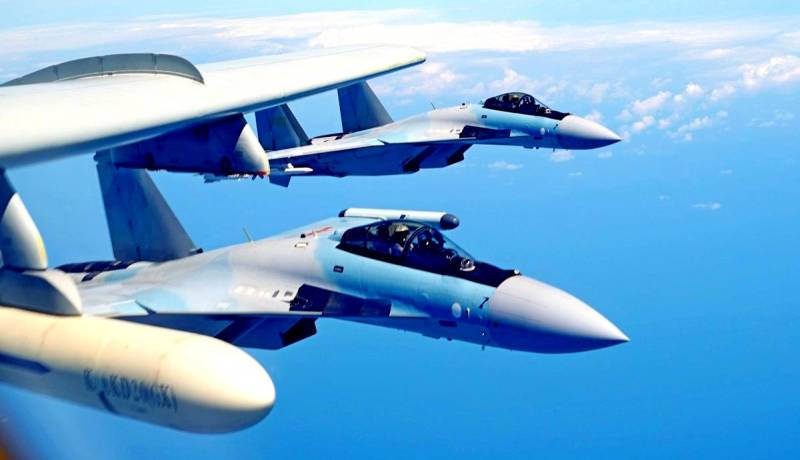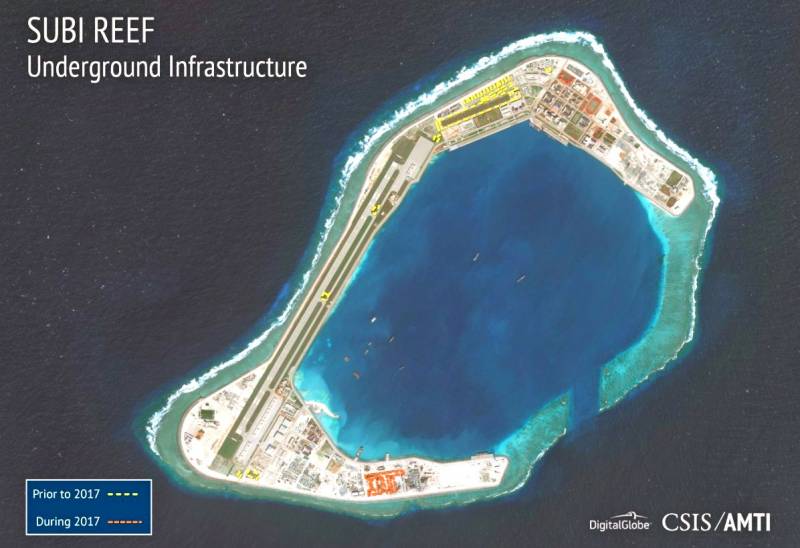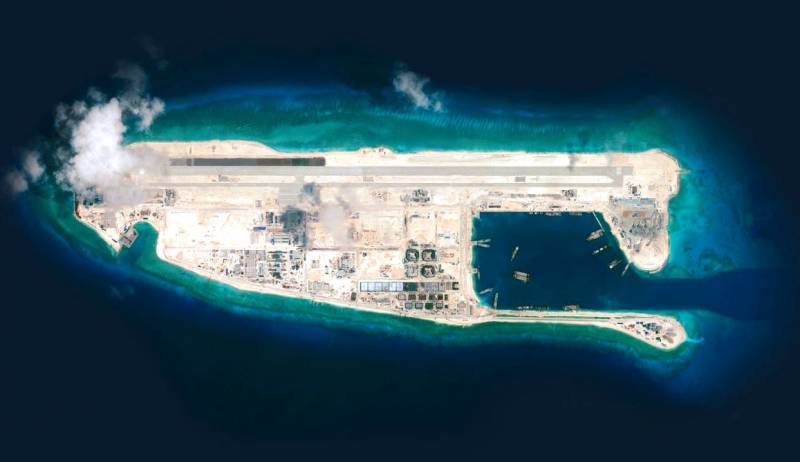Why is the US so nervous about China's “earth carrier”
Political (or rather geopolitical) conflict around the South China Sea is long-term. Which, however, is not surprising, because this confrontation can determine the future global superpower. China is not yet strong enough to openly challenge the United States. But for now.
South big sea
A bit of geography. The South China Sea is a Pacific semi-enclosed sea near Southeast Asia. It is located between the Indochina Peninsula, the islands of Kalimantan, Palawan, Luzon and Taiwan. The sea washes the territories of China, Vietnam, Thailand, the Philippines, Malaysia: rather powerful and, most importantly, dynamically developing countries. Vessels that travel from Chinese, Japanese and Russian ports to the Strait of Singapore and back in the direction of the South China Sea adhere to the so-called Main Sea Route. This is the shortest and conditionally safe way.
In fact, the South China Sea is now the new Great Silk Road. Global processes have turned it into the busiest crossroads of the planet. It is estimated that approximately 25% of all world trade passes through this segment of the oceans. According to some estimates, it accounts for 60% of Chinese trade and 80% of China's hydrocarbon imports. Simply put, the country controlling this sea will automatically gain control over the sea. economies other Asian countries. Just because most of the trade at the regional level can be stopped. With completely unpredictable results for the whole world.
There is another important nuance, which experts also often emphasize. In 2016, Vietnam's GDP grew by 6,2%, of the Philippines - 6,9%. Many openly say that Southeast Asia is the future economic center of the world (in fact, it is already partly such). Rapid economic growth will ensure the rise of all spheres: cultural, political, ideological. So, in their own right, those who say that in the future the West may become the periphery of human civilization, and the Asian southeast will become the first violin. Therefore, to explain in detail why China, on the one hand, and the United States and its allies, on the other, are trying to establish complete control in the region, it makes no sense. Their aspirations are understandable, logical and justified.
Wings and ships
Apart from the nuclear triad, US power is based primarily on the Air Force and Navy. Not one fleet of the world can compare with the American fleet. There are only ten Nimitz-class aircraft carriers in the ranks, and here is the first and parent Gerald R. Ford recently adopted. Soon, his air group will be replenished with the fifth-generation now-officially decked F-35Cs: invisible and capable of carrying up to eight GBU-53 / B guided bombs in the internal compartments.
About the submarines, which are so fond of discussing in the post-Soviet space, it also makes no sense to talk. American submarines win both qualitatively and quantitatively. Three dozens of fourth-generation Virginia planned for construction will be "let down" by anyone, and there are also the legendary Sivulfs and, of course, Los Angeles, of which there is now a huge flotilla (the Americans built 62 such boats, but many already written off).
The US Navy is the embodiment of the triumph of militarism and the desire to dominate everywhere and always. This is hundreds of billions of dollars on water, under water and in the sky. No one wants to live face to face with such an armada, and above all, China does not want to. Celestial Empire perfectly sees the weaknesses of its naval forces, and that is why it has made their strengthening one of the most important tasks of the state.
Western authors are very fond of speculating about the military rise of China, but most often it looks like children's horror stories. Now the Chinese have only one battle-worthy aircraft carrier: this is the long-suffering Liaoning, converted from the Soviet Varyag project 1143. Among military experts, this type of ship is notorious due to shortcomings, such as the relatively small number of aircraft, the lack of a launch catapult, etc. d. By the way, the basis of the Liaoning Air Group is the J-15s that have already become obsolete. These are the Chinese copies of the fourth-generation Soviet Su-33. Such aircraft are "too big" for Liaoning: why the Chinese did not choose, for example, the new Russian MiG-29K - one can only guess.
In 2020, the Celestial Empire intends to put into operation the Shandong aircraft carrier. This is a ship of purely Chinese construction, but created with an eye to the experience of the USSR and representing, in fact, the development of Project 1143. That is, the capabilities of American aircraft carriers that can carry up to 90 aircraft are very, very far away.
The real breakthrough here will be the construction of the new Type 002 aircraft carrier, which was laid relatively recently. In short, it will be a super-bearer, similar to the Gerald Ford. Instead of a springboard on the flight deck there will be a catapult, some sources even say that it is electromagnetic, like on new US ships. This will significantly expand the combat capabilities of the aviation group. Displacement "Type 002" may be about 80 thousand tons. This is less than that of Nimitz, but more than Admiral Kuznetsov. Allegedly, they can build a ship by 2021, but in general this particular date is doubtful. China has no experience in creating ships of such a level, and whether the Celestial Empire will cope at all is not known.
Chinese "aircraft carriers"
Artificial islands will become a really powerful military argument even before the appearance of super-carriers from China. In recent years, they have become the subject of serious political disagreements, mainly between Beijing and the United States. Their construction is carried out in the area of the Spratly Islands and the Paracel Selskiy archipelago.
The new high-quality images clearly show runways, hangars, radars and equipment needed to control the satellite space constellation. At the berths are warships and transport ships.
In fact, we are talking about giant earthen “aircraft carriers”, perfectly protected by anti-aircraft missile systems. These are real naval fortresses along the path of the US allies. And recently, China sent military planes there for the first time. Fighting vehicles, among which was the Xian H-6 strategic bomber, landed at one of the island airfields. The latter is a licensed copy of the Soviet Tu-16, but is capable of carrying modern missiles and having, of course, a large combat radius. In this regard, one cannot but recall the appearance in China of a fifth-generation fighter J-20. Surely the Celestial Empire at some stage will try to use this trump card in the geopolitical struggle.
What the United States thinks about this is not difficult to guess. Western experts have already managed (and more than once) to express concern about the militarization of the South China Sea. According to experts, the current dynamics can lead to the Philippines losing up to 40% of the sea area, where there are large oil reserves and fishing companies are active. Recently, by the way, Malaysia also expressed its position, saying that it does not intend to give up rights to small islands located in the Spratly archipelago. However, she will not qualify for new territories.
Forecasting is not grateful. However, it is worth saying that the chances of a full-fledged big war between China and the United States are negligible. Due to a) the highest degree of economic integration of the two most powerful powers in the world; b) the presence of both nuclear weapons. Of course, nobody wants a nuclear war: there can be no winners. And this means that the Chinese and Americans will have to agree and make concessions on issues that are not too significant for them.
South big sea
A bit of geography. The South China Sea is a Pacific semi-enclosed sea near Southeast Asia. It is located between the Indochina Peninsula, the islands of Kalimantan, Palawan, Luzon and Taiwan. The sea washes the territories of China, Vietnam, Thailand, the Philippines, Malaysia: rather powerful and, most importantly, dynamically developing countries. Vessels that travel from Chinese, Japanese and Russian ports to the Strait of Singapore and back in the direction of the South China Sea adhere to the so-called Main Sea Route. This is the shortest and conditionally safe way.
In fact, the South China Sea is now the new Great Silk Road. Global processes have turned it into the busiest crossroads of the planet. It is estimated that approximately 25% of all world trade passes through this segment of the oceans. According to some estimates, it accounts for 60% of Chinese trade and 80% of China's hydrocarbon imports. Simply put, the country controlling this sea will automatically gain control over the sea. economies other Asian countries. Just because most of the trade at the regional level can be stopped. With completely unpredictable results for the whole world.
There is another important nuance, which experts also often emphasize. In 2016, Vietnam's GDP grew by 6,2%, of the Philippines - 6,9%. Many openly say that Southeast Asia is the future economic center of the world (in fact, it is already partly such). Rapid economic growth will ensure the rise of all spheres: cultural, political, ideological. So, in their own right, those who say that in the future the West may become the periphery of human civilization, and the Asian southeast will become the first violin. Therefore, to explain in detail why China, on the one hand, and the United States and its allies, on the other, are trying to establish complete control in the region, it makes no sense. Their aspirations are understandable, logical and justified.
Wings and ships
Apart from the nuclear triad, US power is based primarily on the Air Force and Navy. Not one fleet of the world can compare with the American fleet. There are only ten Nimitz-class aircraft carriers in the ranks, and here is the first and parent Gerald R. Ford recently adopted. Soon, his air group will be replenished with the fifth-generation now-officially decked F-35Cs: invisible and capable of carrying up to eight GBU-53 / B guided bombs in the internal compartments.
About the submarines, which are so fond of discussing in the post-Soviet space, it also makes no sense to talk. American submarines win both qualitatively and quantitatively. Three dozens of fourth-generation Virginia planned for construction will be "let down" by anyone, and there are also the legendary Sivulfs and, of course, Los Angeles, of which there is now a huge flotilla (the Americans built 62 such boats, but many already written off).
The US Navy is the embodiment of the triumph of militarism and the desire to dominate everywhere and always. This is hundreds of billions of dollars on water, under water and in the sky. No one wants to live face to face with such an armada, and above all, China does not want to. Celestial Empire perfectly sees the weaknesses of its naval forces, and that is why it has made their strengthening one of the most important tasks of the state.
Western authors are very fond of speculating about the military rise of China, but most often it looks like children's horror stories. Now the Chinese have only one battle-worthy aircraft carrier: this is the long-suffering Liaoning, converted from the Soviet Varyag project 1143. Among military experts, this type of ship is notorious due to shortcomings, such as the relatively small number of aircraft, the lack of a launch catapult, etc. d. By the way, the basis of the Liaoning Air Group is the J-15s that have already become obsolete. These are the Chinese copies of the fourth-generation Soviet Su-33. Such aircraft are "too big" for Liaoning: why the Chinese did not choose, for example, the new Russian MiG-29K - one can only guess.
In 2020, the Celestial Empire intends to put into operation the Shandong aircraft carrier. This is a ship of purely Chinese construction, but created with an eye to the experience of the USSR and representing, in fact, the development of Project 1143. That is, the capabilities of American aircraft carriers that can carry up to 90 aircraft are very, very far away.
The real breakthrough here will be the construction of the new Type 002 aircraft carrier, which was laid relatively recently. In short, it will be a super-bearer, similar to the Gerald Ford. Instead of a springboard on the flight deck there will be a catapult, some sources even say that it is electromagnetic, like on new US ships. This will significantly expand the combat capabilities of the aviation group. Displacement "Type 002" may be about 80 thousand tons. This is less than that of Nimitz, but more than Admiral Kuznetsov. Allegedly, they can build a ship by 2021, but in general this particular date is doubtful. China has no experience in creating ships of such a level, and whether the Celestial Empire will cope at all is not known.
Chinese "aircraft carriers"
Artificial islands will become a really powerful military argument even before the appearance of super-carriers from China. In recent years, they have become the subject of serious political disagreements, mainly between Beijing and the United States. Their construction is carried out in the area of the Spratly Islands and the Paracel Selskiy archipelago.
The new high-quality images clearly show runways, hangars, radars and equipment needed to control the satellite space constellation. At the berths are warships and transport ships.
In fact, we are talking about giant earthen “aircraft carriers”, perfectly protected by anti-aircraft missile systems. These are real naval fortresses along the path of the US allies. And recently, China sent military planes there for the first time. Fighting vehicles, among which was the Xian H-6 strategic bomber, landed at one of the island airfields. The latter is a licensed copy of the Soviet Tu-16, but is capable of carrying modern missiles and having, of course, a large combat radius. In this regard, one cannot but recall the appearance in China of a fifth-generation fighter J-20. Surely the Celestial Empire at some stage will try to use this trump card in the geopolitical struggle.
What the United States thinks about this is not difficult to guess. Western experts have already managed (and more than once) to express concern about the militarization of the South China Sea. According to experts, the current dynamics can lead to the Philippines losing up to 40% of the sea area, where there are large oil reserves and fishing companies are active. Recently, by the way, Malaysia also expressed its position, saying that it does not intend to give up rights to small islands located in the Spratly archipelago. However, she will not qualify for new territories.
Forecasting is not grateful. However, it is worth saying that the chances of a full-fledged big war between China and the United States are negligible. Due to a) the highest degree of economic integration of the two most powerful powers in the world; b) the presence of both nuclear weapons. Of course, nobody wants a nuclear war: there can be no winners. And this means that the Chinese and Americans will have to agree and make concessions on issues that are not too significant for them.



Information